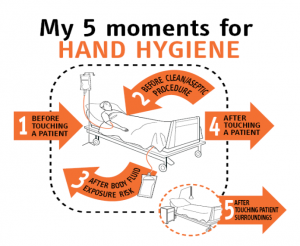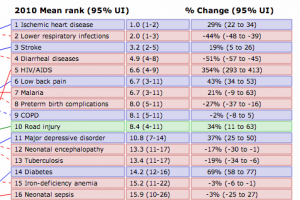The second week of the Emerging trends in global health course focused on infectious diseases which at first glance doesn’t appear to be a topic that is particularly relevant to physiotherapy / physical therapy. However there were several important issues raised during this week which led us to reflect on the role the profession does have in relation to this type of diseases.
When considering the impact of disease and disability on society the measure of a Disability-Adjusted Life Year (DALY) was introduced.
One DALY can be thought of as one lost year of “healthy” life. The sum of these DALYs across the population, or the burden of disease, can be thought of as a measurement of the gap between current health status and an ideal health situation where the entire population lives to an advanced age, free of disease and disability.
WHO definition of a DALY
The “Big Five” infectious diseases with the greatest impact measured in terms of mortality and DALYs and are Pneumonia, Diarrhoea, HIV/AIDS, Tuberculosis and Malaria. The impact of these diseases are concentrated on different areas of the globe and different parts of the population most often the poor and children in low income countries. The table below shows the global impact of diseases and risks ranked by DALY.
In addition to the Big Five, HealthCare-Associated Infections (HAI) affect millions of patients worldwide each year in both developed and developing countries. It was stated that the burden of HAI is greater than HIV/AIDS, Tuberculosis and Malaria together. This is an extremely important problem demonstrated by the following statistics:
An estimated five million HAI occur in acute care hospitals in Europe annually, contributing to 135 000 deaths per year and representing around 25 million extra days of hospital stay and a corresponding economic burden of €13–24 billion… …In the US 1.7 million affected patients and an annual economic impact of US$ 6.5 billion in 2004
WHO Guidelines on hand hygiene in healthcare: a summary
This problem is also very important in low income countries where rates of healthcare associated infections are significantly higher then in developed countries (e.g. 4.5% in the US versus 18.7% in Mali) although data for these countries is very limited.
To address this problem the World Health Organisation (WHO) has encouraged the global adoption of alcohol hand sanitisation which has dramatically reduced the time necessary for hand hygiene. This allows hand sanitisation to be carried out much more regularly and effectively in the healthcare environment. In order to make this economically viable in low income countries WHO has worked to develop cheap local manufacture of the alcohol based cleaner based on a waste product of sugar cane processing.
There has been significant progress towards the Millenium Development Goal 6 (MDG6: combat HIV/AIDS, malaria and other diseases) which is summarised here (WHO progress towards MDGs including 6). One class of infectious disease where there is progress to be made is with the “neglected tropical diseases” which are a diverse group of diseases that generally affect rural populations in the tropical regions.
One very important issue relating to large scale outbreaks of infectious disease is the official communication provided for the general public. This aims to minimise the impact of the epidemic without causing panic. A motto guiding good practice in this communication was highlighted:
Be right, be first, be credible
U.S. Dept. of Health and Human Services
Implications for physiotherapy and physical therapy
As healthcare workers it is important that we recognise the symptoms of the most important infectious diseases and direct sufferers to appropriate treatment as quickly as possible. It is also important to be aware of the role physiotherapy/physical therapy has in treating and advising patients suffering from these diseases (e.g. the benefits of exercise for patients with HIV/AIDS). View the related pages on Physiopedia for more information and please do add to these important pages where appropriate (thanks to the Pathophysiology of Complex Patient Problems project by Bellarmine University which developed these pages):
- Pneumonia
- Diarrhoea and related dehydration
- HIV/AIDS
- Tuberculosis
- Malaria
The statistics related to HealthCare Associated Infections make it clear hand hygiene in the healthcare environment is extremely important. As physiotherapists we need to learn how to use the alcohol hand rubs effectively and utilise these frequently. The WHO guidelines identify 5 moments for hand hygiene:
- Before touching the patient
- Before clean/aseptic procedure
- After body fluid exposure risk
- After touching a patient
- After touching patient surroundings

We should also encourage our colleagues to take hand hygiene seriously. The promotional video below helps get the message across.
The concept of a Disability-Adjusted Life Year (DALY) seems particularly relevant to physiotherapy /physical therapy as our work strives to reduce the impact of a disease or disability on a persons health and quality of life. Our impact could be quantified using a measure such as a DALY which could be used to highlight the important contribution of the profession to policy makers and politicians.
Finally there is a lesson in the motto “Be right, be first, be credible” which our profession could learn from when making ourselves heard on the important health issues of the day.
